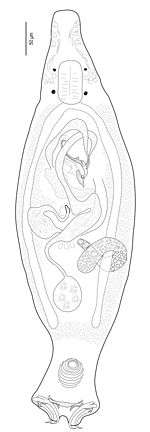Lethrinus rubrioperculatus
Lethrinus rubrioperculatus, common names the spotcheek emperor, red-eared emperor, red-ears, red-edged emperor, scarlet-cheek emperor, and spot cheek emperor,[3] is a species of emperor fish.[2]
| Lethrinus rubrioperculatus | |
|---|---|
| Scientific classification | |
| Kingdom: | |
| Phylum: | |
| Class: | |
| Order: | |
| Family: | |
| Genus: | |
| Species: | L. rubrioperculatus |
| Binomial name | |
| Lethrinus rubrioperculatus | |
Description
This species grows to and is brown or olive-grey in colour. It has small, scattered blotches that are irregular in chape. The Body depth 2.94 to 3.18 times in standard length. Body color is olive-gray or brown, with scattered irregular small black blotches. There is normally a red spot present on the top edge of the operculum.[4] The lips are normally red. The fins are pinkish or pale in colour.[5]
Distribution
Lethrinus rubrioperculatus is found in numerous locations, including East African waters, southern Japan and Taiwan, the Marquesas Islands, New Caledonia[6][7] and the northern half of Australia.[4][8]
Habitat
This species lives over sandy bottoms, in areas where rubble is present, and along the slopes of outer reefs.[4] Although reef-associated, Lethrinus rubrioperculatus also occurs at depths of up to 160 metres, much deeper than most other species in this genus.[9] This species is non-migratory.[5][5]
Diet
Lethrinus rubrioperculatus eats mostly crustaceans, mollusks, echinoderms, and other fishes.[4]
Human uses
This fish is caught commercially.[4]
Parasites

As most fish, Lethrinus rubrioperculatus is the host of many species of parasites.[11] Monogeneans parasitic on the gills include the diplectanid Calydiscoides euzeti,[10] the ancyrocephalids Lethrinitrema gibbus and Lethrinitrema dossenus[12] and several capsalids.[11] Copepods parasitic on the gills include the caligid Caligus lethrinicola[13] and the lernanthropid Sagum vespertilio.[11] The gills also harbour unidentified gnathiid isopod larvae.[11] The digestive tract harbours an unidentified Acanthocephala,[11] unidentified tetraphyllid cestodes,[11] species of the anisakid nematode Raphidascaris (Ichthyascaris),[14] and a variety of digeneans, including the acanthocolpid Stephanostomum aaravi,[15] the hemiurid Lecithochirium sp. and Tubulovesicula angusticauda,[11] the opecoelid Pseudoplagioporus interruptus[11] and three other opecoelids.[11] The abdominal cavity contains two species of larval tetrarhynch cestodes, the otobothriid Otobothrium parvum[11] and the tentaculariid Nybelinia goreensis.[11] In New Caledonia, where its parasites were particularly studied, Lethrinus rubrioperculatus has a total of twenty species of parasites.[11]
References
- Sato, T. (1978). Synopsis of the Sparoid Fish Genus Lethrinus, with the Description of a New Species. Bulletin No.15A Tokyo: The University Museum, The University of Tokyo.
- "WoRMS - World Register of Marine Species - Lethrinus rubrioperculatus Sato, 1978". Marinespecies.org. Retrieved 2014-05-26.
- "Lethrinus". Fishesofaustralia.net.au. Retrieved 2014-05-27.
- "Lethrinus rubrioperculatus - Spotcheek Emperor". Discover Life. 2012-07-03. Retrieved 2014-05-27.
- "Lethrinus rubrioperculatus, Spotcheek emperor : fisheries". Fishbase.sinica.edu.tw. 2012-07-03. Retrieved 2014-05-27.
- Laboute, P. & Grandperrin, R. (2000). Poissons de Nouvelle-Calédonie. Nouméa, New Caledonia: Éditions Catherine Ledru.
- Fricke, R., Kulbicki, M. & Wantiez, L. 2011: Checklist of the fishes of New Caledonia, and their distribution in the Southwest Pacific Ocean (Pisces). Stuttgarter Beitraege zur Naturkunde Serie A (Biologie), 4, 341–463.
- Atlas of Living Australia (2009-05-19). "Lethrinus rubrioperculatus : Spotcheek Emperor | Atlas of Living Australia". Bie.ala.org.au. Retrieved 2014-05-27.
- "Lethrinus rubrioperculatus". Guammarinelab.com. Archived from the original on 2015-09-24. Retrieved 2014-05-27.
- Justine, J.-L. 2007: Species of Calydiscoides Young, 1969 (Monogenea: Diplectanidae) from lethrinid fishes, with the redescription of all of the type-specimens and the description of C. euzeti n. sp. from Lethrinus rubrioperculatus and L. xanthochilus off New Caledonia. Systematic Parasitology, 67, 187-209. doi:10.1007/s11230-006-9087-x
- Justine, J.-L., Beveridge, I., Boxshall, G. A., Bray, R. A., Moravec, F. & Whittington, I. D. 2010: An annotated list of fish parasites (Copepoda, Monogenea, Digenea, Cestoda and Nematoda) collected from Emperors and Emperor Bream (Lethrinidae) in New Caledonia further highlights parasite biodiversity estimates on coral reef fish. Zootaxa, 2691, 1-40. Open-Access PDF
- Lim, L. H. S. & Justine, J.-L. 2011: Two new species of ancyrocephalid monogeneans from Lethrinus rubrioperculatus Sato (Perciformes: Lethrinidae) off New Caledonia, with the proposal of Lethrinitrema n. g. Systematic Parasitology, 78, 123-128. doi:10.1007/s11230-010-9283-6
- Boxshall, G. A. & El-Rashidy, H. H. 2009: A review of the Caligus productus species group, with the description of a new species, new synonymies and supplementary descriptions. Zootaxa, 2271, 1-26.
- Moravec, F. & Justine, J.-L. 2012: Raphidascaris (Ichthyascaris) etelidis n. sp (Nematoda, Anisakidae), a new ascaridoid nematode from lutjanid fishes off New Caledonia. Zoosystema, 34, 113-121. doi:10.5252/z2012n1a4
- Bray, R. A. & Justine, J.-L. 2011: Acanthocolpidae (Digenea) of marine fishes off New Caledonia, with the descriptions of two new species. Folia Parasitologica, 58, 35-47. doi:10.14411/fp.2011.004